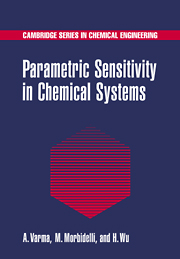Book contents
- Frontmatter
- Contents
- Preface
- 1 Introduction
- 2 Introduction to Sensitivity Analysis
- 3 Thermal Explosion in Batch Reactors
- 4 Runaway in Tubular Reactors
- 5 Parametric Sensitivity in Continuous-Flow Stirred Tank Reactors
- 6 Runaway in Fixed-Bed Catalytic Reactors
- 7 Parametric Sensitivity and Ignition Phenomena in Combustion Systems
- 8 Sensitivity Analysis in Mechanistic Study and Model Reduction
- 9 Sensitivity Analysis in Air Pollution
- 10 Sensitivity Analysis in Metabolic Processes
- Author Index
- Subject Index
9 - Sensitivity Analysis in Air Pollution
Published online by Cambridge University Press: 04 May 2010
- Frontmatter
- Contents
- Preface
- 1 Introduction
- 2 Introduction to Sensitivity Analysis
- 3 Thermal Explosion in Batch Reactors
- 4 Runaway in Tubular Reactors
- 5 Parametric Sensitivity in Continuous-Flow Stirred Tank Reactors
- 6 Runaway in Fixed-Bed Catalytic Reactors
- 7 Parametric Sensitivity and Ignition Phenomena in Combustion Systems
- 8 Sensitivity Analysis in Mechanistic Study and Model Reduction
- 9 Sensitivity Analysis in Air Pollution
- 10 Sensitivity Analysis in Metabolic Processes
- Author Index
- Subject Index
Summary
The prediction of pollutant distribution in the atmosphere from emission sources and meteorological fields is a primary objective of air pollution studies. In general, this requires solving the so-called Eulerian atmospheric species diffusion-reaction equations, which describe the time evolution of the pollutant concentration in the atmosphere in the presence of wind, diffusion processes, reaction, and source terms. These models tend to be complex, involving many physicochemical parameters and complex reaction mechanisms, whose quantitative evaluation is frequently not straightforward. Thus, in order to assess the reliability of a model, it is important to evaluate the influence of uncertainties in physicochemical, kinetic, and meteorological parameters on model predictions. This can be done conveniently using sensitivity analysis, which often accompanies the solution of atmospheric diffusion-reaction models. An important problem, particularly for air quality control, is to determine the influence of a specific source on a specific target location (usually referred to as a receptor). This type of information is not given directly by the solution of the Eulerian model, but can be obtained from sensitivity analysis.
The sensitivity analysis of model predictions with respect to uncertainties in input parameters has been described in previous chapters, where we examined local sensitivities that account for small one-at-a-time parameter variations. In order to investigate air pollution problems noted above, we first need to introduce some new concepts of sensitivity analysis. In particular, in Section 9.2, we illustrate a specific technique that is well suited to evaluate the relations between receptor and emission sources, where the latter may vary in space and time. This is still a type of local sensitivity analysis, but with the sensitivity definition based on functional rather than partial derivatives.
- Type
- Chapter
- Information
- Parametric Sensitivity in Chemical Systems , pp. 287 - 311Publisher: Cambridge University PressPrint publication year: 1999
- 1
- Cited by



